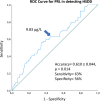Low prolactin level identifies hypoactive sexual desire disorder women with a reduced inhibition profile
- PMID: 37204690
- PMCID: PMC10632269
- DOI: 10.1007/s40618-023-02101-8
Low prolactin level identifies hypoactive sexual desire disorder women with a reduced inhibition profile
Abstract
Purpose: Data on the role of prolactin (PRL) in the physiologic range in the female sexual response are scanty. We aimed at investigating the association between PRL and sexual function as assessed by the Female Sexual Function Index (FSFI). We explored the presence of a cut-off level of PRL able to identify Hypoactive Sexual Desire Disorder (HSDD).
Methods: 277 pre- and post-menopausal women consulting for Female Sexual Dysfunction (FSD) and sexually active were enrolled in an observational, retrospective study. 42 women were used as no-FSD controls. A clinical, biochemical and psychosexual evaluation was performed. The main outcome measures were: FSFI, Female Sexual Distress Scale-Revised, Middlesex Hospital Questionnaire and Sexual excitation/sexual inhibition scale (SIS/SES).
Results: Normo-PRL FSD women (n = 264) showed lower FSFI Desire score than controls (n = 42), and higher than hyper-PRL FSD women (n = 13). These differences emerged both in pre-menopausal and post-menopausal subjects. In the normo-PRL FSD group, those with PRL in the higher quintile reported higher FSFI Desire scores than those with PRL in the lowest quintile. Women with HSDD presented a lower PRL level than those without (p = 0.032). A ROC curve analysis for PRL showed an accuracy of 0.610 ± 0.044 (p = 0.014) in predicting HSDD. With a threshold of < 9.83 μg/L, sensitivity and specificity for HSDD were 63% and 56%, respectively. Subjects with PRL < 9.83 μg/L also reported lower sexual inhibition (p = 0.006) and lower cortisol levels (p = 0.003) than those with PRL > = 9.83 μg/L.
Conclusions: Hyper-PRL is associated with low desire; however, among normo-PRL FSD women, those with the lowest levels demonstrated a poorer desire than those with the highest levels. PRL < 9.83 μg/L predicted HSDD and a lower sexual inhibitory trait.
Keywords: Desire; Female sexual dysfunction; Hypoprolactinemia; Prolactin; Sexual distress.
© 2023. The Author(s).
Conflict of interest statement
LV received scientific research grants, advisory board attendance and speaker honoraria from Therascience, Theramex, Bayer Schering Pharma, Intercept, Lipocine, Ibsa. REN had past financial relationships (lecturer, member of advisory boards and/or consultant) with Boehringer Ingelheim, Ely Lilly, Endoceutics, Gedeon Richter, HRA Pharma, Merck Sharpe & Dohme, Procter & Gamble Co, TEVA Women’s Health Inc and Zambon SpA. At present, she has ongoing relationship with Astellas, Bayer HealthCare AG, Exceltis, Fidia, Novo Nordisk, Organon & Co, Palatin Technologies, Pfizer Inc, Shionogi Limited and Theramex. None of these companies are relevant to the present work.EM, NV, SC, GR, CA, DC, RS, MM, FP, RSA, and MM have nothing to declare.
Figures



References
-
- Riddle O, Bates RW, Dykshorn SW. The preparation, identification and assay of prolactin – a hormone of the anterior pituitary. Am J Physio. 1933;105:191–216. doi: 10.1152/ajplegacy.1933.105.1.191. - DOI
MeSH terms
Substances
LinkOut - more resources
Full Text Sources
Medical

